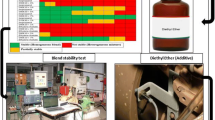Abstract
This paper deals with the main physical-chemical properties of ethanol-diesel blend and the effects of ethanoldiesel blends (up to 15% volume) on engine performance (full load torque vs. engine speed, BSEC vs. torque at 1400 r/min and 2300 r/min, and effect of start of injection angle) and emissions in ECE R49 tests (steady 13 points) using a 6.6 L inline 6-cylinder turbocharged direct injection diesel engine. The results show that an increase in ethanol fraction results in decreased viscosity of the blend fuel and very high distillation characteristics in the low temperature range. Solvents can improve the solubility of ethanol-diesel blends. The engine power was degraded proportional to the ethanol content (10% and 15%) due to the LHV (low heating value) of the blends. The higher latent heat of vaporization and lower CN (cetane number) of ethanol, which results from the steady state emissions of CO, HC, and SOF (soluble organic fraction), were much higher in the ECE R49 tests at low loads. Soot (solid mass) emissions were improved. The particulate matter emissions were significantly increased with higher blend volumes, and NOx emissions slightly increased with higher ethanol volumes. By increasing the injection angle properly, the performance parameters of the diesel engine were improved, but NOx emissions were deteriorated slightly.
Similar content being viewed by others
References
Ajav, E. A., Singh, B. and Bhattacharya, T. K. (1999). Experimental study of some performance parameters of a constant speed stationary diesel engine using ethanoldiesel blends as fuel. Biomass and Bioenergy, 17, 357–365.
Caro, P. S., Mouloungui, Z., Vaitilingom, G. and Berge, J. C. (2001). Interest of combining an additive with dieselethanol blend diesel engines. Fuel, 80, 565–574.
Corkwell, K., Akarapanjavit, N., Srithammavong, P., Schuetzle, D. and Han, W. (2002). The development of diesel/ethanol fuel blends for diesel vehicles: Fuel formulation and prosperities. The 14th Int. Symp. Alcohol Fuels (ISAF XIV), Phuket, Thailand.
Cui, X. C. (1990). The Alternative Fuel for Internal Combustion Engine. Machinery Publisher of China. 44–60.
Hansen, A. C., Zhang, Q. and Lyne, P. W. L. (2005). Ethanoldiesel fuel blends — A review. Bioresource Technology, 96, 277–285.
He, B. Q., Shuai, S. J., Wang, J. X. and He, H. (2003). The effect of ethanol blended diesel fuels on emissions from a diesel engine. Atmospheric Environment, 37, 4965–4971.
Kremer, F. G. and Fachetti, A. (2000). Alcohol as automotive fuel-Brazilian experience. SAE Paper No. 2000-01-1965.
Li, D. G., Huang, Z., Lǔ, X. C., Zhang, W. G. and Yang, J. G. (2005). Phisico-chemical properties of ethanol-diesel blend fuel and its effect on performance and emissions of diesel engines. Renewable Energy, 30, 967–976.
Lü, X. C., Huang, Z., Zhang, W. G. and Li, D. G. (2005). Combustion visualization and emissions of a direct injection compression ignition engine fueled with biodiesohol. Int. J. Automotive Technology 6,1, 15–21.
Lü, X. C., Yang, J. G., Zhang, W. G. and Huang, Z. (2004). Effect of cetane number improver on heat release rate and emissions of high speed diesel engine fueled with ethanol-diesel blend fuel. Fuel, 83, 2013–2020.
Poulopoulos, S. G., Samaras, D. P. and Philippopoulos, C. J. (2001). Regulated and unregulated emissions from an internal combustion engine operating on ethanol-containing fuels. Atmospheric Environment, 35, 4399–4406.
Qudais, M. A., Haddad, O. and Qudaisat, M. (2000). The effect of alcohol fumigation on diesel engine performance and emissions. Energy Conversion & Management, 41, 389–399.
Urban Lofvenberg (2002). E-diesel in Europe: A new available fuel technology. The 14th Int. Symp. Alcohol Fuels (ISAF XIV), Phuket, Thailand.
Author information
Authors and Affiliations
Corresponding author
Rights and permissions
About this article
Cite this article
Chen, Z.Q., Ma, X.X., Yu, S.T. et al. Physical-chemical properties of ethanol-diesel blend fuel and its effect on the performance and emissions of a turbocharged diesel engine. Int.J Automot. Technol. 10, 297–303 (2009). https://doi.org/10.1007/s12239-009-0034-0
Received:
Revised:
Published:
Issue Date:
DOI: https://doi.org/10.1007/s12239-009-0034-0




